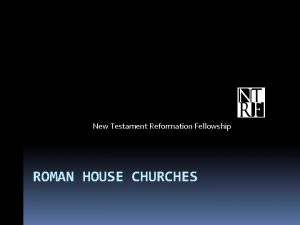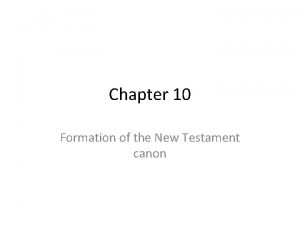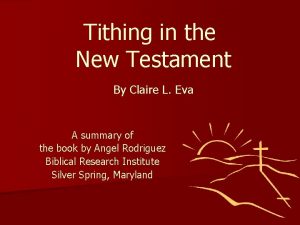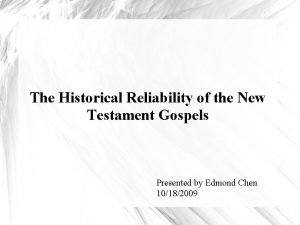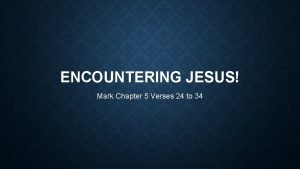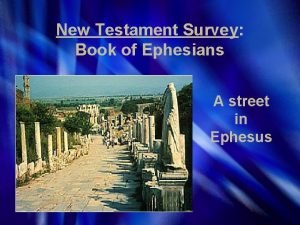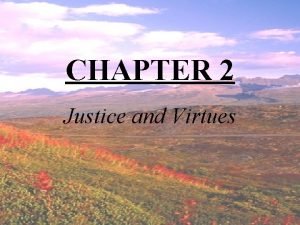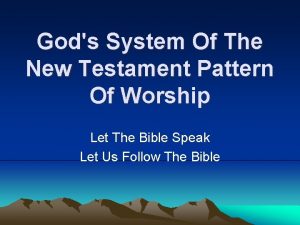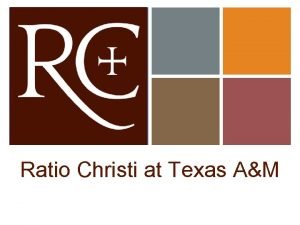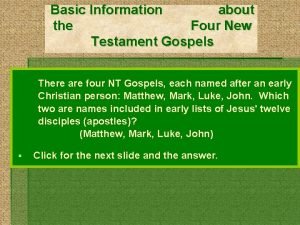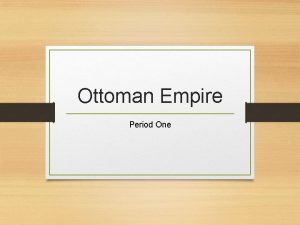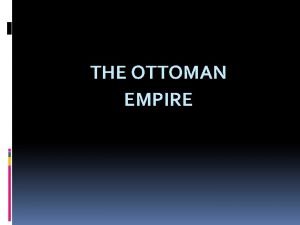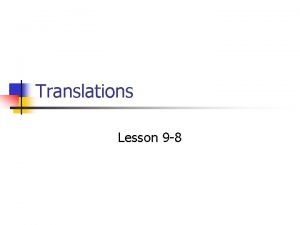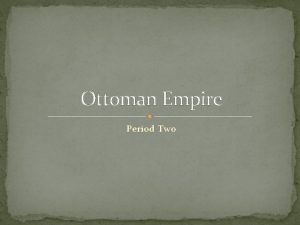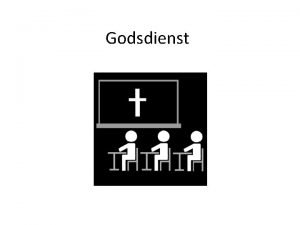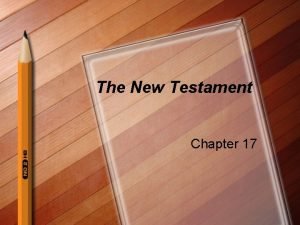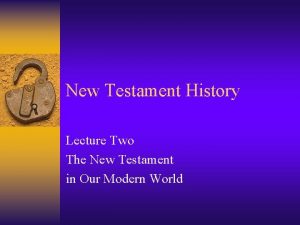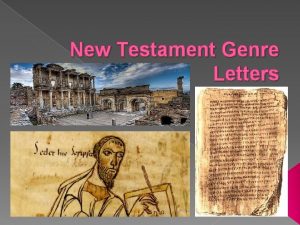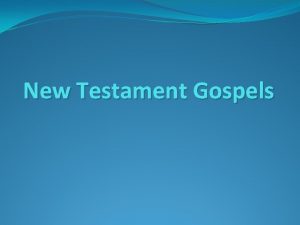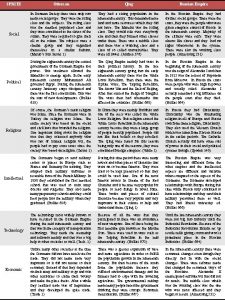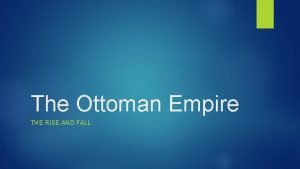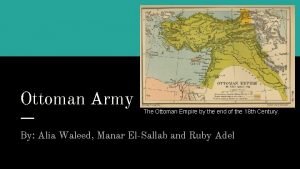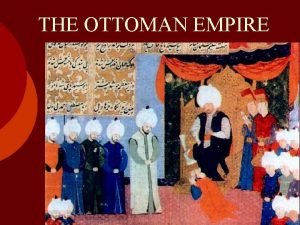NEW TESTAMENT TRANSLATIONS on the OTTOMAN PERIOD XIIIXIX





























- Slides: 29

NEW TESTAMENT TRANSLATIONS on the OTTOMAN PERIOD (XIII-XIX CENTURY) Sadık YAZAR Istanbul University zyazar@gmail. com

Introduction (1) translation exists in Süleymaniye Library Donated Manuscripts no. 2518: Introduction (2) Translations of the Bible made by Turks (Except Ottoman Period) (1) Translations of the Bible made by Turks (Except Ottoman Period) (2) A Translation of the Mark Gospel into Tatar Dialect in the Suleymaniye Library Translations of the Bible in Ottoman Period The First Translations of the Bible into Turkish in Arabic Script: The Translation of Hâkî and. Alî Ufkî Bey and His Bible Translation (1) Alî Ufkî Bey and His Bible Translation (2) A Translation With An Unknown Translator: The Turkish Linguistic Society Copy (TLS 19) İsmail Ferruh’s Translation (1) İsmail Ferruh’s Translation (2) An Uncompleted Translation: The

Introduction (1) Studies devoted to the history of translation constitute one of the research subjects of translation studies, which is an independent branch of knowledge in the present day. With these studies, which deal with translation practices and theories, certain research types are taken into consideration such as country, region, linguistic or cultural association. (1) Translation studies of the Koran, the Old Testament and the New Testament take place in these research types too. I, in my paper, want to mention Bible translations on the Ottoman period, basing on a historical period (Ottoman period) and a specific text (the Bible). In this sense, I am going to try to present the manuscripts which contain a number of Bible translations that I could find during my research. While doing so, I am going to take these translations in hand bibliographically; therefore, there is going to be no detailed investigation in these translations in terms of linguistic and translation studies. I want to state that while making my research, although using online

The Religious Distribution of the Turks Turkish World Muslims Animistic and Shaman Buddhist s Juwishs Christian

Introduction (2) As known; because of emigration, war, missionary activities and one of the characteristics of Turks, “religious tolerance”, Turks have accepted many religions and affected by them along history. In this context, aside from their traditional religion, “Gök-Tengri”, they have been affected by universal religions such as Buddhism, Manichaeism, Zoroastrianism, Christianity, Judaism and Islam. (1) Even though around the world, especially in the West, mentioning Turkishness brings Islam to minds; Turks have been affected by other universal religions. One of these, Christianity (2), is the second common religion after Islam according to the researchers of this subject. Although, according to some researchers the history of Turks meeting Christianity goes to 2 nd century A. D. , it is understood that Christianity began spreading out in Central Asia in the end of V. century. Even though Christianity (Nestorianism sect) that spreading among Turks in Central Asia failed against Islam, Orthodoxy and partly a number of other Christian sects could managed to diffuse and moreover to form permanent communities among Turks living in East Europe, the Balkans, Anatolia, Russia and Siberia. (1)About the religious history of Turks, see: Ünver Günay; Harun Güngör, Türklerin Dini Tarihi, İstanbul 1997, Ocak Yayınları; Hikmet Tanyu, Türklerin Dini Tarihçesi, İstanbul 1978, Türk Kültür Yayını; Fuat Bozkurt, Türklerin Dini, İstanbul 1995, Cem

Translations of the Bible made by Turks (Except Ottoman Period) (1) After having embraced Christianity, Turks, who generally compose a literature under the influence of the religion which they are affiliated with, also composed a literature around this religion. According to the researches, the oldest translation of the Bible is made on Uyghur period, and the surviving two papers have been pressed in Turpan texts. (1) After this translation, which was thought to be the Jacobous or Mathew Gospel, we observe that Turk societies who immigrated to Central Europe and embraced Christianity have practiced Bible translations. With Bulgarian Turks’ accepting Christianity, the Bible was translated into Bulgarian Slavic for the first time. (2) Cuman-Kipchaks embraced Christianity as a whole, while their hegemony was coming to an end. Accordingly, Roman Catholic missionaries translated the Bible and its spiritual tunes into Turkish. (3)

Translations of the Bible made by Turks (Except Ottoman Period) (2) Gagauz people, who are the sequels of the Christian Turks in Central Asia, also translated the Bible into their language. Mihail Ciachir undertook this job in 1934. (1) After living in Anatolia through centuries, Christian Karaman (Larende) Turks, who was sent to Greece due to the Treaty of Lausenne in 1923, translated the Bible into Turkish with Greek letters. (2) The Bible’s translation into modern Uyghur was made by Johannes Avetaranian, who converted from Islam to Christianity, and in 1989, only the Four Gospels chapter was pressed by British and Foreign Bible Society. This was followed by the Cairo press of Lars Erik Hogberg and G. Sauerwein in 1939. After Swedish population was driven from Xinjiang, Gustaf Ahlbert, Oskar Hermannson, Dr. Nur Luke (a Uyghur), Moulvi Munshi and Moulvi Fazil completed the translation of the Bible and this was pressed by British and Foreign Bible Society in Cairo, in 1950. (2) The translations of the Bible into Central Asian Turkish dialects such as Uzbek, Azerbaijani and Tatar were started by the support of Institute for Bible Translation, the Russian Bible Society, British and Foreign Bible Society, by the end of the 19 th century and at the present such studies still continue (3) (1) Günay-Güngör, age. , s. 155.

A Translation of the Mark Gospel into Tatar Dialect in the Suleymaniye Library Now I would like to mention about a translation in Tatar language which exists in Suleymaniye Library now, (Arslan Kaynardag collection number 246). This manuscript translation is in Arabic script and was written in 1925. It consists of 50 folios and there is only Gospel of Mark translation in it. There is a map entitled “Filistin yirinün haritası” (the map of the Palestine region) at the top of the translation. And the translator is remained to be unknown.

Translations of the Bible in Ottoman Period (1) Looking at the Ottoman period, we see that two different literatures developed around the Bible. While one of these formed around Islamic creed, the other one formed around the translations of the whole Holy Scripture or some parts of it. According to Islamic creed, while the Bible with the Torah, which constitutes initial five chapters of the Holy Scripture, in fact was sent by the God as a holy text, it was altered later on. It is believed that there has been a lot change in these texts, initially the subject of Muhammad’s coming as a prophet. Hence, an Islamic literature was developed about this issue. Scholars such as Cahız (ö. 869), İbn Hazm (ö. 1064), Gazzâlî (ö. 1111), Ebü’l-bekâ Sâlib b. Hüseyin el. Ca’ferî (ö. 1221), Cüveynî (ö. 1283), Şehâbeddîn el-Karâfî (ö. 1285), Abdüsselâm b. Teymiyye el-Harrânî (ö. 1327 -28), İbn Kayyim (ö. 1350), Abdullâh et-Tercümân (ö. 1432? ), Şemdüddîn Muhammed b. Abdurrahmân es-Sehavî (1496), Şeyh Ebü’l-fazl es-Su’ûdî (ö. after 1535 -36), Rahmetullâh el-Hindî (ö. 1888), Muhammed Ebû Zehre (ö. 1974) (1) have directly or indirectly mentioned the basic subjects like tampering of the Bible and the Torah and heralding Mohammed in the

Translations of the Bible in Ottoman Period (2) This Islam based literature continued in Ottoman period and other books with the same theme was written by Muslim-Turk scholars of the Ottoman period such as Abdurrahmân Bâçecizâde, Hâcegizâde Mustafa b. Muhammed (ö. 1589), İbrahim Müteferrika (ö. 1747) and Abdülahad Dâvûd (1930) (1). Along with this Islam based literature, we come across with another literature which is consisted of the translations of the whole Holy Scripture or some parts of of it like Four Bibles and the Psalter (soltar). It is possible to see examples (manuscripts) of this literature in libraries both in and out of Turkey. We put emphasis on the translations of this literature’s New Testament chapter, in other words, on the translations of the New Testament in Ottoman period.

Translations of the Bible in Ottoman Period (3) There is some information about translations of the Bible in Ottoman period which is considered as rumor (1). It is stated that the oldest translation we currently have, belongs to an English orientalist William Seaman (1606 -1680). Seaman, who was in Istanbul between 1628 -1639 first had translated and pressed the “the Letters of John” part of the New Testament. And after that, in 1666, he translated whole of the New Testament and pressed in Oxford. (1) For instance, it is said by Jean Deny that a philologic comitee which was under Protestant missonary Primus Truber, translated Holy Scripture into Croatian and Turkish in the late 16 th century. (2) Cem Behar, Ali Ufkî ve Mezmurlar, İstanbul 1990, Pan Yayıncılık, s. 26. For the mentioned press see: William Seaman,

The First Translations of the Bible into Turkish in Arabic Script: The Translation of Hâkî and. Alî Ufkî Bey The first Turkish translation of the Bible in Arabic script is first made by Yahyâ b. İshak pen named Hâkî and then by Ali Ufkî Bey (1610 -1675? ) as a content of a project. The project of translating the Holy Scripture into Turkish, was started by a Czech, Jan Amos Komensky, also known as Comenius (15921670). Everything, including the financial support needed for press was planned for this project. The most important part of this project, the translating job was asked from Levinus Warner (1619 -1665), who had been in Istanbul many times on behalf of Holland. However, Warner was too busy to undertake the job and he asked Hâkî pan named Yahyâ b. İshak and then Alî Ufkî Bey to do it. (1) Hâkî, who is thought to be a Jewish, completed his translation in 1659. However, for an unknown reason, Warner did not like the translation. (2) Then, Alî Ufkî Bey was asked to make a

Alî Ufkî Bey and His Bible Translation (1) Polish Ali Ufkî Bey’s first name was Wojciech Bobowski. Alî Ufkî is thought to born in 1610. According to a common opinion, he was brought to Istanbul as a captive and was taken to the court as a slave. He served 19 years in the court and in a date between 1652 and 1662 he left. After leaving, he turned back to the court as a dragoman of the Ottoman Court (Dîvân-ı Hümâyûn). As the general opinion of western sources, he died in 1675. (1) While staying in Istanbul, Alî Ufkî Bey wrote close to 10 books about music, religion and Turkish language. Each of these has different importance and specifically his Mecmû’a-i Sâz u Söz entitled work which means a lot for history of Turkish music and his Holy Scripture translation are really important. (2) Upon being ordered for the translation of the Holy Scripture, Alî Ufkî first works on Hâkî’s translation and took his notes and then started to his own translation. He completed it in 1664. It was sent to Leiden with Hâkî’s translation. After examining, Ali Ufkî Bey’s translation was decided to press. However, by the

Alî Ufkî Bey and His Bible Translation (2) The complete press of the translation came true 150 years after the owner of project’s death, in 1827. Before that date, in 1739, first four chapters of the Genesis and in 1819, the New Testament chapter was pressed. The translation, whole of which was pressed in Latin script in Paris in 1827 was also pressed in Greek, Armenian and Arabic scripts in different periods. It was first pressed in Istanbul in 1870. Alî Ufkî Bey’s Holy Scripture translation was also pressed in modern Turkish with Latin script in 1941. (1) Both Hâkî’s and Alî Ufkî Bey’s manuscript copies of their Holy Scripture translations are now in Holland, in Leiden Academic library. Hâkî’s translation, partly published after an extensive examining by Hannah Neudecker. (2)The Four Gospels, which was a part of Alî Ufkî’s translation, has been transcribed with Latin script(3)by Funda Toprak (4) (1) See: Hannah Neudecker, The Turkish Bible Translation by Yahya bin İshak also called Haki (1659), Leiden 1994 (2) Behar, age. , s. 28 -32. (3) (2) The manuscripts of Hâkî’s Holy Scripture translation are kept today in 4 piece with Cod. Or. 386, Cod. Or. 391 a-d code numbers in the Warner collection of Leiden University’s Library. Definition of the manuscripts has been made by Hannah Neudecker. See. (s. 383 -398). They are also in a catalog

A Translation With An Unknown Translator: The Turkish Linguistic Society Copy (TLS 19) One of the Turkish Bible translations with Arabic script we currently have is registered to the Turkish Linguistic Society Library, in the Manuscript Works section with the number Yz. A 19. It consists of 259 folios and there is not the slightest clue about when or by whom it has been made. On the first page of the manuscript, there are some information given about the New Testament chapter of the Holy Scripture. This information is followed by the Four Gospels and Acts of the Apostles chapter. However Acts of the Apostles chapter is not complete there are only 3 chapters. Other chapters of the New Testament do not take part in the manuscript. There are Gospel of Matthew between 2 a-73 b; Gospel of Mark between 73 b 118 b; Gospel of Luke between 118 b-197 a; Gospel of John between 197 a-253 b and 3 chapters of Acts of the Apostles between the folios 253 b-259 b in the manuscript. This Turkish version of the Bible has been Latinized by İbrahim Ethem Özkan as a dissertation study. (1) Although there is a facsimile edition of this translation it is understood that it has not been analysed in terms of language and translation features. Nevertheless, in the way of the translating method and the language used, it has interesting features. In this translation; when we pay attention to the words translated from the written source (it couldn’t have been determined which

İsmail Ferruh’s Translation (1) Another translation of the Bible was made by someone called İsmail Ferruh in 19 th century which meets the last period of Ottoman. This translation exists in Bâyezîd State Library in Istanbul (the Bâyezîd collection no. 51) and includes only the translation of the Four Gospels. Just by looking both at the top (1 a) and the bottom (page 269) of the manuscript, it can be understood that it belongs to İsmail Ferruh. The first inscription (at the top of the manuscript) which is not known whether it is inscribed by the translator or by someone else is: ﻣﻮﺍﻛﺐ ﺻﺎﺣﺒﻰ ﺍﺳﻤﻌﻴﻞ ﻓﺮﺥ ﺍﻓﻨﺪﻯ ﺧﻄﻰ ﻭ ﺗﺮﺟﻤﻪ ﺳﻴﺪﺭ “Mevâkib sâhibi İsmâ’îl Ferruh Efendi hattı ve tercümesidir” “Copied and translated by İsmail Ferrûh Efendi who is the author of Mevâkib” Another inscription found at the bottom of the translation that is clear to be written by it’s translator is: ﺗﺤﺮﻳﺮﻩ ﻭﺗﺮﺟﻤﺘﻪ ﻋﻦ ﺍﻟﻌﺮﺑﻰ ﺑﻘﻠﻢ ﻓﺮﺥ “tahrîrühü ve tercemetühü ‘ani’l-Arabî bi-kalemi Ferruh sene 1236” (Written by Ferruh translating from Arabic) As we find out the identity of the translator from these two inscriptions, we also understand that the translation is made from Arabic and in 1820 -21.

İsmail Ferruh’s Translation (2) Looking at biographic written sources, we understand that İsmail Ferruh is a Crimean, that he translated Vâ’iz-i Kâşifi’s Koran exegesis into Turkish and that he passed away in İstanbul in 1256/1840 -41. Even though it is mentioned in the sources (1), Ferruh who is known by exegesis translation namely Mevâkib, also poetically translated the seventh volume of Mevlana’s Mesnevî which is debated to exist, there is no refer to his Four Gospels translation we are trying to present here. His translation consists of 269 pages which each one contain 21 lines. There stands Matthew Gospel between 1 -75, Mark Gospel between 77 -123, Lıke Gospel 125 -204 and John Gospel 205 -269 translations. In his translation, in the beginning of each Gospel; Arabic, Frankish, Greek and Armenian pronunciation of the author’s name is given. For instance, in the beginning of John Gospel, it says “[This Gospel] authored by someone whose name is pronounced as Yuhannâ in Arabic, Jan and Covanni in Frankish; Yani in Greek, Uhanes in Armenian”. İsmail Ferruh’s and Alî Ufkî Bey’s translations resemble each other on the whole. Moreover, it is possible to see the same sentences.

An Incompleted Translation: The translation exists in Süleymaniye Library Donated Manuscripts no. 2518: At the top of this manuscript translation, there stands this inscription: “Ulemâ-yı Nasrâniyyece Hz. Îsâ Efendimiz semâvâta su’ûd buyurduklarından (çıktıktan) otuz sene sonra Hz. Markos tarafından yazılmış İncil-i şerîfin tercümesidir. Bu kitâbdan müşârun ileyh (adı geçen) İncil-i şerifin sekiz bâbı mefkûd olduğından tercüme dokuzuncu bâbın yirmi beşinci adedinden bed’ ider. (başlar)” (According to Christian scholars; this is the translation which was written by Mark, 30 years after Jesus ascended to heaven. As its nine chapters are lost, this gospel starts from the twenty fifth verse of the ninth chapter. ) As it is understood from this inscription; this translation is the one which was made from the beginning of 25 th verse of Gospel of Mark’s 9 th chapter. There is no information about who and when this translation of 12 folios was made and which written source was used while doing it. The translation discontinued in the depth of 28 th verse of 13 th chapter. It is thought that the translator could not finish his translation or the other parts of the translation

A Work Contain Translation of Some Bible Verses (1) Except for the Bible translations which we presented above, I also would like to mention another work which was not a direct translation of the Bible and which was written in order to justify the fact that Mohammed was heralded in the Torah and the Bible. It was written by a Hungarian who became later a Muslim. Though it is not a direct translation from the Bible, it should not be ignored as it involves translations of the Bible and the Torah verses. In Süleymaniye Library, I could reach three copies of this translation, the name and the writer’s name of these copies are not known unfortunately. It is registered as “Tercüme-i Ba’z-ı yât-ı Zebûr ve Tevrât ve İncîl”, (The translation of some verses of Psalter, Torah and New Testament) “Tercüme-i Ba’z-ı yât-ı İncîl” (The translation of

A Work Contain Translation of Some Bible Verses (2) The author, while not mentioning his name, gives some hints about his life. He was born in Kolojvar in Hungary. Reading the Torah, the Bible and the Psalter with their interpretations since his childhood, he was authorized to preach. One day he sees a verse, which was forbidden to read for being “null” by his teachers. He sees Muhammed was heralded in it. And thus he accepts Islam. With his acceptance, he decides to inscribe some of the verses of the Torah and the Bible written in Greek which indicated that Mohammed will come as a prophet at the end of the world and that Ottoman Empire will pervade everywhere from East to the West and translate them into Turkish. The actual purpose of the author is to translate several Torah verses which heralded Mohammed into Turkish by transcribing them with Arabic script. But he also says that he will consider a few verses which clearly indicate

A Work Contain Translation of Some Bible Verses (3) None of the three copies we could reach has a copyright date. But, from the information provided in the introduction of the work, we understand that author presented his work to Sultân Ahmed b. sultân Mehmed In Ottoman history, there are only two sultans who had this identity. One is I. Ahmed who ruled between 1603 and 1617, and the other is 3 th Ahmed who ruled between 1703 and 1730. Both their father’s name is Mehmed. So we can not understand which Sultan Ahmed the work was presented to. There are 14 texts which were translated into Turkish after writing the Greek text in Arabic script. Also there are several stories which are translated into Turkish without their Greek texts. Being brief, I want to finish this manuscript’s interpret after telling the most important three elements of it. v. The fact that Mohammed was heralded in the Torah and the Bible was taken in hand by someone who became a Muslim later on and who claims that he knows the Torah and the Bible very well. v. Transcribing a Greek text with Arabic script which constitutes a new material for the researchers of aljamiado literature. v. Translation of the chapters in the Holy Scripture which is the most important fact for us.

A Work Contain Translation of Some Bible Verses (4) A similar work with the manuscript above is also present between the 57 b-60 a folios of a corpus in Süleymaniye Library Ali Nihat Tarlan collection no. 144. The reproducing date of this short work whose author we can not determine is 1205 / 1790 -91. By the information given in the beginning of his manuscript, it is understood that he was Athenian who embraced Islam. This unknown author, who was cognizant of the Latin and Greek versions of the Holy Scripture, translated the verses which indicated prophethood of Mohammed, into Turkish after transcribing them in Arabic alphabet with scrutinizing the Psalter and the Bible.

Manuscripts of the Bible Translation into Turkish Outside Turkey These are the manuscripts which contain Turkish Bible translations which I saw in person or know with the help of another research that they exist in consequence of my research. However, after researching, I saw that there a number of Turkish Bible translations outside Turkey. For instance, the Turkish Bible translation which is told to be in Marciena Library in Italy, Orientali No: 108 by Mesîh b. İbrâhim; the translation in French National Library Turkish Manuscripts, Regius collection, copied in 1680 and in same library Saint-Germain-des-Pres no 512 bis. are one of the translations which I saw but could not check. Also there is one Turkish translation in Australia Dukedom Library Gotha Collection Turkish Manuscript

General Information of the Translations at Hand 1. Written sources: After analyzing Hâkî’s translation, Hannah Neudecker thinks that Hebrew Bible version might have inspired him. Coming up with many evidences with this issue, Neudecker still utters that judging is too difficult. (1) Also, there is not any certain information about the text which was the source of the TLS 19 version and Alî Ufkî Bey’s translation. Arabic translation of the Bible was the source of İsmail Ferruh’s translation. But there is no information given about whom this Arabic version belonged to. (1) Neudecker, age. , s. 275 -308 Versions Hâkî Ali Ufki TDK 19 İsmail Ferruh YB 2518 Table. The. I: source Thetext Source Textsunknown of the unknown Turkish Bible Translations Hebrew text? Arabic text unknown

General Information of the Translations at Hand 1. Marking System: In all the Turkish Bible translations we presented, chapter and verse orders are someway explained. While numbering scheme was used in Haki, Ali Ufki and YB 2518 versions, in TLS 19 and Ferruh versions, big dots were put at the end of the verses.

General Information of the Translations at Hand 1. Language and Translation: When we analyse the Bible translations on hand in terms of language and translation; (if we exclude the incomplete YB 2518) we will have two groups in doubles. As a result of our analysis on the information Neudecker gave and the text (Samuel I, II) she published, we see that Haki’s translation and TLS 19 resemble each other. Besides, while the translations of Ali Ufki and İsmail Ferruh generally Hâkî – TDK 19 Ufkî – İsmail Ferruh resemble in terms of language and translation, they Alî significantly differentiate from -those in the first group. Language is plainer, the - Language is more complicated, the equivalent words for the source equivalent words are more Arabic text consist of more Turkish and Persian based words than second group. - On the whole, the loyalty of Turkish - The loyalty of sentence structure was in the of source text’s was in the foreground. - Translating the meaning into - As a translation method; it relies Turkish is more important than on translating the words more word by word translation. than the meaning.

General Information of the Translations at Hand 1. Language and Translation: Turkish Bible translations generate two group in this way, on account of their language and translation characteristics; however, there are some important differences between the translations of Ali Ufki and İsmail Ferruh. First of all, İsmail Ferruh used more Arabic and Persian words in order to be equivalents for the written source. He used longer sentences than Ali Ufki Bey did and also it is possible to see the trace of an Islamic ambience around İsmail Ferruh.

Conclusion and Some Wishes Till recent epoch; it was believed in Ottoman period that the translation of the New Testament chapter of the Holy Scripture was only translated by Ali Ufki Bey. This effort clearly showed the inaccuracy of this idea which had been used in many scientific and popular studies. After our research which is made mostly based on Istanbul libraries; with a copy whose date of being written is not known, it is determined that there are five different Bible translations two of which are from 17 th century, and the other two are from 19 th century. While two of them constitute a part of the translation of the Holy Scripture, İsmail Ferruh’s translation and TLS copy are made up of only the translation of the Four Gospels. As for YB 2518 copy, it is just an incomplete translation which contains a part of Mark Gospel. According to the documents on hand, the first translation of the New Testament on Ottoman period was made by a westerner orientalist, William Seaman, in Latin. The first translations in Arabic (Haki and Ali Ufki’s translations) were also made with the support of Westerners. However, when language characteristics are taken into consideration, the possibility that TLS copy had been written earlier should not be ignored. Except the translations of Haki and Ali Ufki Bey, which came out as part

Conclusion and Some Wishes This research whose results I have been presenting you, constitutes only a tiny part of the research that should be done about Turkish Bible translations. Before ending my speech, I would like to make a few wishes. (1) First of all, by searching all of the manuscript libraries in the world, a strong bibliography of Turkish Bible translations made in Ottoman period should be prepared. (2) The translated texts should be properly Latinized and presented to the researchers. (3) These texts should be analyzed in terms of language and the translation studies. (4) While translating The Holy Scripture or just the New Testament
 Encouraging words for offering and tithes
Encouraging words for offering and tithes House churches in the new testament
House churches in the new testament Tithe in new testament
Tithe in new testament Encountering jesus in the new testament answer key
Encountering jesus in the new testament answer key Encountering jesus in the new testament
Encountering jesus in the new testament Greek word canon
Greek word canon Tithing in the new testament
Tithing in the new testament Reliability of new testament
Reliability of new testament Test: the general epistles new testament survey
Test: the general epistles new testament survey New testament reformation fellowship
New testament reformation fellowship Matthew mark luke john books of the bible
Matthew mark luke john books of the bible Encountering jesus in the new testament
Encountering jesus in the new testament Is titus in the old or new testament
Is titus in the old or new testament Music in new testament
Music in new testament New testament survey book
New testament survey book Justice and virtue
Justice and virtue 27 new testament books
27 new testament books New testament pattern of worship
New testament pattern of worship New testament canon
New testament canon New testament doctrinal mastery
New testament doctrinal mastery Choose life new testament
Choose life new testament Four new testament gospels
Four new testament gospels Critical period vs sensitive period
Critical period vs sensitive period Absolute refractory period and relative refractory period
Absolute refractory period and relative refractory period When is the relative refractory period
When is the relative refractory period Critical period vs sensitive period
Critical period vs sensitive period Critical period
Critical period Critical period vs sensitive period
Critical period vs sensitive period Less complicated texture than baroque (more homophonic)
Less complicated texture than baroque (more homophonic) Period 2 atomic mass 11
Period 2 atomic mass 11

